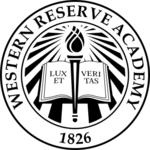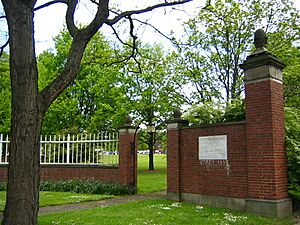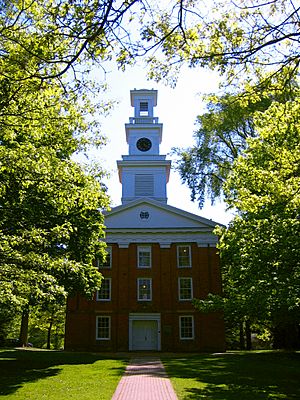Western Reserve Academy facts for kids
Western Reserve Academy (WRA), often called Reserve, is a private high school in Hudson, Ohio, USA. It's a special kind of school called a college-preparatory school. This means it helps students get ready for college. WRA is also a boarding school, so many students live right on campus. About 280 out of 390 students live there, while others attend as day students. Students come from over 20 different states and 15 countries to study at WRA.
Quick facts for kids Western Reserve Academy |
|
|---|---|
 |
|
| Address | |
|
115 College Street
, Ohio
44236-2999
United States
|
|
| Coordinates | 41°14′55″N 81°26′08″W / 41.248685°N 81.435494°W |
| Information | |
| Former name | Western Reserve College and Preparatory School |
| Type | Independent college-preparatory boarding and day high school |
| Motto | Latin: Lux Et Veritas (Light and Truth) |
| Established | 7 February 1826 |
| Founder | David Hudson |
| Status | Currently operational |
| Trust | Board of Trustees |
| CEEB code | 362655 |
| NCES School ID | 01064121 |
| President | Martin D. Franks '68 Nathaniel E. Leonard '82 |
| Head of school | Suzanne Walker Buck |
| Faculty | 51.4 (on a FTE basis) |
| Grades | 9–12 |
| Gender | Coeducational |
| Enrollment | 390 (2019-2020) |
| • Grade 9 | 84 |
| • Grade 10 | 103 |
| • Grade 11 | 84 |
| • Grade 12 | 119 |
| Average class size | 11 |
| Student to teacher ratio | 7.6:1 |
| Hours in school day | 7.2 |
| Campus size | 190 acres (77 ha) |
| Campus type | Suburban |
| Color(s) | Hunter Green and White |
| Athletics | 23 interscholastic |
| Nickname | Pioneers |
| Rivals | University School The Kiski School Linsly School |
| Accreditation | HLC |
| SAT average | 1340 |
| Endowment | $64.42 million |
| Annual tuition | $71,250 (boarding) $46,000 (day) |
| Revenue | $38.11 million |
| Affiliation | GCSDAC, NAIS, and TABS |
| Website | |
|
Western Reserve Academy
|
|
| Lua error in Module:Location_map at line 420: attempt to index field 'wikibase' (a nil value). | |
| Location | Roughly bounded by Aurora St. and both sides of Oviatt, High, Hudson, Ohio |
| Area | 58 acres (23 ha) |
| Architect | Porter, Simeon; Et al. |
| Architectural style | Greek Revival, Federal |
| NRHP reference No. | 75001539 |
| Added to NRHP | June 30, 1975 |
Contents
History of Western Reserve Academy
Western Reserve Academy started on February 7, 1826. It was first called the Western Reserve College and Preparatory School. The school was built in Hudson, Ohio, on a large piece of land. This land was set aside by the Ohio government.
Reserve is one of the oldest boarding schools in the United States. It is the oldest one outside of the Northeast region.
Why the Name "Western Reserve"?
The school's name comes from the area where it was built, the Connecticut Western Reserve. It was the first school of its kind in Northern Ohio. Settlers from Connecticut wanted to build a school as good as Yale College. They even chose a similar building style with brick buildings. They also picked the same motto: Lux et Veritas, which means "Light and Truth." People used to call it "the Yale of the West."
Early Years and Changes
The first group of students included eleven at the college level and eight at the high school level. In 1882, the college part of the school moved to Cleveland. It became Western Reserve University. Later, it joined with another school to form Case Western Reserve University.
Western Reserve Academy stayed open in Hudson for another 21 years. But in 1903, it had to close because of money problems.
Reopening and New Buildings
In 1916, the school reopened thanks to James Ellsworth. He was a former student and a wealthy businessman. During this time, many new buildings were constructed. These included Seymour Hall (for classes), the Bicknell Gymnasium, and Ellsworth Hall (a dorm and dining hall).
In 1922, Western Reserve Academy became an all-boys school. It stayed that way for 50 years. Then, in 1972, girls were welcomed back into the junior class. This made it a co-ed school again.
In 2001, U.S. News & World Report recognized Western Reserve Academy. They named it one of the top boarding schools in the country.
Student Activities and Sports
Athletics Programs
The school offers many different sports. These include soccer, golf, cross country, field hockey, volleyball, swimming, basketball, wrestling, and more. They also have baseball, softball, track and field, tennis, and lacrosse.
Lacrosse Success
Western Reserve Academy has a very strong lacrosse team. In 2006 and 2009, WRA won the Midwest Scholastic Lacrosse Championship. They were ranked among the top teams nationally. Only a few teams have won this championship since 1992.
Track and Cross-Country Achievements
The track and cross-country teams were very successful from the 1940s to the 1980s. They won many championships. The cross-country team once had an amazing record of 179 wins to only 1 loss. The school's track is named after a famous coach, Frank Longstreth. It hosts the annual Frank Longstreth Relays.
Soccer and Rivalries
In 2012, both the girls' and boys' soccer teams were highly ranked in the state. The boys' team had an undefeated season. The girls' teams broke the record for most wins in a season.
WRA has a long-standing sports rivalry with University School, which started in 1895. Other rival schools include The Kiski School and Linsly School.
Arts Programs
Reserve offers over 20 different classes for students who love the arts. You can take courses in music, dance, theater, and visual arts. There are special rooms for 2D and 3D art. There's also a computer lab for graphic design and a workshop for woodworking.
Most art classes happen in the Knight Fine Arts Center (KFAC). The music program is in Hayden Hall. KFAC has classrooms, a theater, and a dance studio. The Moos Gallery, also in KFAC, shows student art and works by famous artists.
KFAC is also home to the Wang Innovation Center (WIC). Here, students can take special classes that combine different subjects.
School Traditions
Western Reserve Academy has many fun traditions.
Vespers and Sit-Down Meals
One popular tradition is Vespers. This is a Christmas Concert and a special dinner before winter break. Another tradition is sit-down meals. All students and teachers have lunch together every Wednesday. Students sit with their academic advisors or in mixed groups. This helps them get to know each other better.
Victory Bell and Music
The victory bell is another tradition. After a Reserve sports team wins, the players ring a bell. The whole campus can hear it! Students also take part in musical traditions. One is the annual "Messiah Sing" concert. The Academy String Orchestra and Choir perform Handel's Messiah. The audience is invited to sing along to many songs.
Commencement Ceremony
The final tradition for students is Commencement, or graduation. It takes place outside the historic chapel. Graduating boys wear green and white pants, and girls wear white dresses. They walk through campus with bagpipers leading the way. Teachers follow behind them. Each student receives their diploma and a special tie or pin.
Daily Dress Code
Western Reserve Academy has a dress code for students. On Mondays and Fridays, students wear "Reserve Green" dress. This means a green blazer with the school crest or a special sweater over a white collared shirt. Boys wear khaki pants and a green and white striped tie. Girls can wear a green kilt or khaki pants.
On Tuesdays, Wednesdays, and Thursdays, the dress code is more relaxed. Students can wear blouses or collared dress shirts, including polo shirts. They must wear dress pants, skirts, or dresses. Coats, sweaters, and ties are optional on these days.
Campus Buildings
WRA's campus has many old and important buildings.
Chapel and Loomis Observatory
Two buildings that stand out are the Loomis Observatory and the chapel. Both are listed on the National Register of Historic Places. The chapel was built in 1836 and was last updated in 2021. It is still used for morning meetings twice a week. Marriages, concerts, and gatherings also happen there. The graduation ceremony takes place outside the chapel.
The school is not tied to one religion. However, the chapel has a cross that once hung in a Spanish monastery. It is said that Christopher Columbus prayed before this cross.
The Loomis Observatory was built in 1838. It was the third observatory built in the United States. Today, it is the second oldest observatory in the country. It is named after astronomer Elias Loomis. This three-room building is near the music building, Hayden Hall. The building and its old telescope are not open to the public. A newer observatory is used on Cross Country Hill.
Ong Library
The Ong Library is a large building on the south side of campus. It is named after Ambassador John D. Ong. The library has almost 23,000 books, 3,000 DVDs and CDs, and many magazines. Students can use the library all day for studying. It has two computer labs and many group study rooms. The basement holds the Western Reserve Academy Archives Collection. This collection has items from the school's and town's 200-year history.
Student Dormitories
There are ten dormitories where over 200 boarding students live. North Hall, built in 1838, is the oldest. Bicknell House is the newest. Students live in single, double, triple, or quad rooms. They share bathrooms.
Each dorm has 2-3 teachers who live there. One teacher is the Dorm Head. About 85% of all teachers live on campus in homes or dorm apartments.
Notable Alumni and Faculty
Many interesting people have attended or taught at Western Reserve Academy.
Alumni in Public Service
- William B. Allison† — A U.S. senator from Iowa.
- David R. Paige† — A U.S. representative from Ohio.
- Mark Hanna*† — A U.S. senator from Ohio and campaign manager for President William McKinley.
- Louis P. Harvey† — The 7th governor of Wisconsin.
- William H. Upson† 1842 — A U.S. representative from Ohio and a lawyer.
- George Hoadly† — The 36th governor of Ohio.
- James W. Dawes† — The sixth governor of Nebraska.
- George K. Nash† 1860 — The 41st governor of Ohio.
- John Hessin Clarke† — A justice on the U.S. Supreme Court.
- Walter Folger Brown 1888 — The U.S. postmaster general.
- William R. Hopkins 1892 — A politician and the first city manager of Cleveland, Ohio.
- David S. Dennison '36 — A U.S. representative from Ohio.
- Ronald B. Cameron '45 — A U.S. representative from California.
- James Robertson '55 — A federal judge.
- Daniel W. Christman '61 — A former leader at the U.S. Military Academy at West Point.
- Oliver Everett '62 — The Royal Librarian to Elizabeth II of the United Kingdom.
- Thomas C. Sawyer* '63 — A U.S. representative from Ohio.
- Martin R. Hoke '69 — A U.S. representative from Ohio.
- Neel Kashkari '91 — A leader in the U.S. Treasury Department.
Alumni in Writing and News
- Rupert Hughes 1888 — A novelist, film director, and historian.
- Lucien Price 1901 — A journalist for The Boston Globe and an author.
- R. W. Apple Jr. '52 — An editor for The New York Times.
- Martin Perlich '55 — A radio broadcaster and writer.
- Ted Gup '68 — Author of A Secret Gift.
- Chris Gulker '69 — A photojournalist and writer.
- Ian Frazier '69 — A nonfiction author and essayist.
- Andrew Meldrum '70 — A senior editor at GlobalPost.
- John Yang '75 — A correspondent for PBS Newshour.
- Kevin Prufer '88 — A poet, novelist, and essayist.
Alumni in Arts and Entertainment
- D.M. Marshman Jr. '41 — An Academy Award-winning writer for Sunset Boulevard.
- Frederick Coffin '61 — A film and television actor.
- Jeff Schaffer '87 — A film director and TV show writer (like Seinfeld).
- Richard Brake '83 — A film actor (seen in Batman Begins).
- Macy Gray* '84 — A Grammy Award-winning musician and singer.
- Ted Humphrey '87 — An Emmy Award-nominated TV and film writer.
Alumni in Business
- James Ellsworth† 1868 — A coal mine owner and banker.
- James L. Knight '29 — A newspaperman and founder of Knight Ridder.
- William D. Perez '65 — Former CEO of Nike, Inc..
Alumni in Sports
- Keith Carter '48 — An Olympic swimmer who won a silver medal in 1948.
- Brandon Collier '05 – A professional football player.
- Joel Dalgarno '05 — A professional lacrosse player.
- Chris Livingston, a professional basketball player.
Other Notable Alumni
- John Strong Newberry — A geologist and explorer.
- Frederic de Forest Allen — A scholar of ancient languages.
- Lincoln Ellsworth — A U.S. explorer who was the first to clearly see the North Pole.
- Scott E. Forbush '20 — A physicist who discovered the Forbush decrease.
- George Kubler '29 — An art historian.
- Lee Morin '70 — A NASA astronaut.
- Thomas Day Seymour 1870 - An educator.
Notable Faculty Members
- Beriah Green, taught at Western Reserve College and Prefatory Academy.
- Edward Morley, taught at Western Reserve College and Prefatory Academy.
- Joseph Frederick Waring, taught at Western Reserve Academy for 32 years.






